Dendrochronological Analysis of Pinus pinea in Central Chile and South Spain for Sustainable Forest Management
Abstract
Simple Summary
Abstract
1. Introduction
2. Materials and Methods
2.1. Study Sites
2.2. Dendrochronological Study
2.3. Climate Data and Drought Indices
3. Results
3.1. Dendrochronological Statistics and Growth
3.2. Growth Responses to Climate
3.3. Comparing Growth between Countries and between Forest Types
4. Discussion
4.1. Growth Patterns
4.2. Growth Response to Climate
5. Conclusions
Supplementary Materials
Author Contributions
Funding
Institutional Review Board Statement
Informed Consent Statement
Data Availability Statement
Acknowledgments
Conflicts of Interest
References
- IPCC Summary for Policymakers. In Climate Change 2022—Impacts, Adaptation and Vulnerability; Cambridge University Press: Cambridge, UK; New York, NY, USA, 2022; pp. 3–34.
- Zhao, X.; Chen, F.; Seim, A.; Hu, M.; Akkemik, Ü.; Kopabayeva, A.; Mazarzhanova, K.; Zhang, R.; Maisupova, B.; Kirillov, V.; et al. Global Warming Leads to Growth Increase in Pinus sylvestris in the Kazakh Steppe. For. Ecol. Manag. 2024, 553, 121635. [Google Scholar] [CrossRef]
- Mechergui, K.; Saleh Altamimi, A.; Jaouadi, W.; Naghmouchi, S. Climate Change Impacts on Spatial Distribution, Tree-Ring Growth, and Water Use of Stone Pine (Pinus pinea L.) Forests in the Mediterranean Region and Silvicultural Practices to Limit Those Impacts. iForest Biogeosciences For. 2021, 14, 104–112. [Google Scholar] [CrossRef]
- Sánchez-Salguero, R.; Camarero, J.J.; Dobbertin, M.; Fernández-Cancio, Á.; Vilà-Cabrera, A.; Manzanedo, R.D.; Zavala, M.A.; Navarro-Cerrillo, R.M. Contrasting Vulnerability and Resilience to Drought-Induced Decline of Densely Planted vs. Natural Rear-Edge Pinus Nigra Forests. For. Ecol. Manag. 2013, 310, 956–967. [Google Scholar] [CrossRef]
- Valeriano, C.; Gazol, A.; Colangelo, M.; González de Andrés, E.; Camarero, J.J. Modeling Climate Impacts on Tree Growth to Assess Tree Vulnerability to Drought During Forest Dieback. Front. Plant Sci. 2021, 12, 672855. [Google Scholar] [CrossRef]
- Arend, M.; Link, R.M.; Patthey, R.; Hoch, G.; Schuldt, B.; Kahmen, A. Rapid Hydraulic Collapse as Cause of Drought-Induced Mortality in Conifers. Proc. Natl. Acad. Sci. USA 2021, 118, 2025251118. [Google Scholar] [CrossRef]
- Milano, M.; Ruelland, D.; Fernandez, S.; Dezetter, A.; Fabre, J.; Servat, E. Facing Climatic and Anthropogenic Changes in the Mediterranean Basin: What Will Be the Medium-Term Impact on Water Stress? Comptes rendus. Géoscience 2012, 344, 432–440. [Google Scholar] [CrossRef]
- Mazza, G.; Cutini, A.; Manetti, M.C. Site-Specific Growth Responses to Climate Drivers of Pinus pinea L. Tree Rings in Italian Coastal Stands. Ann. For. Sci. 2014, 71, 927–936. [Google Scholar] [CrossRef]
- Peñuelas, J.; Sardans, J.; Filella, I.; Estiarte, M.; Llusià, J.; Ogaya, R.; Carnicer, J.; Bartrons, M.; Rivas-Ubach, A.; Grau, O.; et al. Impacts of Global Change on Mediterranean Forests and Their Services. Forests 2017, 8, 463. [Google Scholar] [CrossRef]
- Cutini, A. Pinus pinea L. In Pines of Silvicultural Importance; CABI, Ed.; CABI Publishing: New York, NY, USA, 2002; pp. 329–343. ISBN 0 85199 539 X. [Google Scholar]
- Perdiguero, P.; Soto, Á.; Collada, C. Comparative Analysis of Pinus pinea and Pinus pinaster Dehydrins under Drought Stress. Tree Genet. Genomes 2015, 11, 70. [Google Scholar] [CrossRef]
- Freire, J.A.; Rodrigues, G.C.; Tomé, M. Climate Change Impacts on Pinus pinea L. Silvicultural System for Cone Production and Ways to Contour Those Impacts: A Review Complemented with Data from Permanent Plots. Forests 2019, 10, 169. [Google Scholar] [CrossRef]
- Sülüsoglu, M. The Management of Villagers Owned Stone Pine (Pinus pinea L.) Plantations in Kozak Region, Turkey, a Case Study; FAO Working Paper; FAO: Rome, Italy, 2004. [Google Scholar]
- Pardos, M.; Calama, R.; Mayoral, C.; Madrigal, G.; Sanchez-Gonzalez, M. Addressing Post-Transplant Summer Water Stress in Pinus pinea and Quercus ilex Seedlings. iForest Biogeosciences For. 2015, 8, 348–358. [Google Scholar] [CrossRef]
- Montero, G.; Calama, R.; Ruiz, R. Selvicoltura de Pinus pinea L. In Compendio de Selvicoltura de Especies; Montero, G., Serrada, R., Reque, J., Eds.; INIA-Fundación Conde del Valle de Salazar: Madrid, Spain, 2008; pp. 431–470. [Google Scholar]
- Natalini, F.; Alejano, R.; Pardos, M.; Calama, R.; Vázquez-Piqué, J. Declining Trends in Long-Term Pinus pinea L. Growth Forecasts in Southwestern Spain. Dendrochronologia 2024, 88, 126252. [Google Scholar] [CrossRef]
- Calama, R.; Montero, G. Cone and Seed Production from Stone Pine (Pinus pinea L.) Stands in Central Range (Spain). Eur. J. For. Res. 2006, 126, 23–35. [Google Scholar] [CrossRef]
- Vallejo, R. Tercer Inventario Forestal Nacional. Ministerio de Agricultura, Alimentación y Medio Ambiente (España/Spain). Version 1.6. Available online: https://www.gbif.org/es/dataset/fab4c599-802a-4bfc-8a59-fc7515001bfa# (accessed on 30 July 2024).
- Garfì, V.; Garfì, G. Differential Tree Growth Response to Management History and Climate in Multi-Aged Stands of Pinus pinea L. Plants 2023, 13, 61. [Google Scholar] [CrossRef]
- Abad Viñas, R.; Caudullo, G.; Oliveira, S.; de Rigo, D. Pinus pinea in Europe: Distribution, Habitat, Usage and Threats. In European Atlas of Forest Tree Species; San-Miguel-Ayanz, J., de Rigo, D., Caudullo, G., Houston Durrant, T., Mauri, A., Eds.; Publication; Office of the European Union: Luxembourg, 2016; p. e01b4fc+. [Google Scholar]
- Harris, I.; Jones, P.D.; Osborn, T.J.; Lister, D.H. Updated High-resolution Grids of Monthly Climatic Observations—The CRU TS3.10 Dataset. Int. J. Climatol. 2014, 34, 623–642. [Google Scholar] [CrossRef]
- Maxwell, R.S.; Larsson, L.-A. Measuring Tree-Ring Widths Using the CooRecorder Software Application. Dendrochronologia 2021, 67, 125841. [Google Scholar] [CrossRef]
- Holmes, R. Computer Assisted Quality Control in Treering Dating and Measurement. Tree-Ring Bull. 1983, 43, 69–78. [Google Scholar]
- Schulman, E. Dendroclimatic Changes in Semiarid America; University of Arizona Press: Tucson, AZ, USA, 1956. [Google Scholar]
- Schöngart, J.; Wittmann, F.; Worbes, M.; Piedade, M.T.F.; Krambeck, H.-J.; Junk, W.J. Management Criteria for Ficus insipida Willd. (Moraceae) in Amazonian White-Water Floodplain Forests Defined by Tree-Ring Analysis. Ann. For. Sci. 2007, 64, 657–664. [Google Scholar] [CrossRef]
- Worbes, M.; Schöngart, J. Measures for Sustainable Forest Management in the Tropics—A Tree-Ring Based Case Study on Tree Growth and Forest Dynamics in a Central Amazonian Lowland Moist Forest. PLoS ONE 2019, 14, e0219770. [Google Scholar] [CrossRef]
- Loader, C. Local Regression and Likelihood; Statistics and Computing; Springer: New York, NY, USA, 1999; ISBN 978-0-387-98775-0. [Google Scholar]
- Bunn, A.G. Statistical and Visual Crossdating in R Using the DplR Library. Dendrochronologia 2010, 28, 251–258. [Google Scholar] [CrossRef]
- R Development Core Team R: A Language and Environment for Statistical Computing; Foundation for Statistical Computing: Vienna, Austria, 2022.
- Fritts, H. Tree Rings and Climate; Academic Press: New York, NY, USA, 1976. [Google Scholar]
- Wigley, T.M.L.; Briffa, K.R.; Jones, P.D. On the Average Value of Correlated Time Series, with Applications in Dendroclimatology and Hydrometeorology. J. Clim. Appl. Meteorol. 1984, 23, 201–213. [Google Scholar] [CrossRef]
- Briffa, K.R.; Jones, P.D. Basic Chronology Statistics and Assessment. In Methods of Dendrochronology: Applications in the Environmental Sciences; Cook, E.R., Kairiukstis, L.A., Eds.; Kluwer Academic Publishers: Dordrecht, The Netherlands, 1990; pp. 137–152. ISBN 978-0-7923-0586-6. [Google Scholar]
- Funk, C.; Peterson, P.; Landsfeld, M.; Pedreros, D.; Verdin, J.; Shukla, S.; Husak, G.; Rowland, J.; Harrison, L.; Hoell, A.; et al. The Climate Hazards Infrared Precipitation with Stations—A New Environmental Record for Monitoring Extremes. Sci. Data 2015, 2, 150066. [Google Scholar] [CrossRef]
- Vicente-Serrano, S.M.; Beguería, S.; López-Moreno, J.I. A Multiscalar Drought Index Sensitive to Global Warming: The Standardized Precipitation Evapotranspiration Index. J. Clim. 2010, 23, 1696–1718. [Google Scholar] [CrossRef]
- Zang, C.; Biondi, F. Treeclim: An R Package for the Numerical Calibration of Proxy-climate Relationships. Ecography 2015, 38, 431–436. [Google Scholar] [CrossRef]
- Efron, B.; Tibshirani, R.J. An Introduction to the Bootstrap, 1st ed.; Chapman and Hall/CRC: New York, NY, USA, 1994; ISBN 9780429246593. [Google Scholar]
- Yu Karpukhin, M.; Yussef, A.M. Electing Drought-Resistant Pinus pinea L. (Stone Pine) Using Dendroclimatology. IOP Conf. Ser. Earth Environ. Sci. 2021, 699, 012051. [Google Scholar] [CrossRef]
- Akkemik, Ü. Dendroclimatology of Umbrella Pine (Pinus pinea L.) in Istanbul, Turkey. Tree-Ring Bull. 2000, 56, 17–20. [Google Scholar]
- Piraino, S.; Roig, F.A. Spring-Summer Drought Induces Extremely Low Radial Growth Reactions in North-Tyrrhenian Pinus pinea L. Floresta e Ambient. 2020, 27, 20180303. [Google Scholar] [CrossRef]
- Loewe-Muñoz, V.; Balzarini, M.; Delard, C.; Del Río, R.; Álvarez, A. Inter-Annual Variability of Pinus pinea L. Cone Productivity in a Non-Native Habitat. New For. 2020, 51, 1055–1068. [Google Scholar] [CrossRef]
- Balekoglu, S.; Caliskan, S.; Dirik, H.; Rosner, S. Response to Drought Stress Differs among Pinus pinea Provenances. For. Ecol. Manag. 2023, 531, e120779. [Google Scholar] [CrossRef]
- Camarero, J.J.; Gazol, A.; Linares, J.C.; Fajardo, A.; Colangelo, M.; Valeriano, C.; Sánchez-Salguero, R.; Sangüesa-Barreda, G.; Granda, E.; Gimeno, T.E. Differences in Temperature Sensitivity and Drought Recovery between Natural Stands and Plantations of Conifers Are Species-Specific. Sci. Total Environ. 2021, 796, 148930. [Google Scholar] [CrossRef]
- Mazza, G.; Sarris, D. Identifying the Full Spectrum of Climatic Signals Controlling a Tree Species’ Growth and Adaptation to Climate Change. Ecol. Indic. 2021, 130, 108109. [Google Scholar] [CrossRef]
- Trowbridge, A.M.; Adams, H.D.; Collins, A.; Dickman, L.T.; Grossiord, C.; Hofland, M.; Malone, S.; Weaver, D.K.; Sevanto, S.; Stoy, P.C.; et al. Hotter Droughts Alter Resource Allocation to Chemical Defenses in Piñon Pine. Oecologia 2021, 197, 921–938. [Google Scholar] [CrossRef]
- Sohn, J.A.; Saha, S.; Bauhus, J. Potential of Forest Thinning to Mitigate Drought Stress: A Meta-Analysis. For. Ecol. Manag. 2016, 380, 261–273. [Google Scholar] [CrossRef]
- IPCC. Climate Change and Land: An IPCC Special Report on Climate Change, Desertification, Land Degradation, Sustainable Land Management, Food Security, and Greenhouse Gas Fluxes in Terrestrial Ecosystems; IPCC: Cambridge, UK; New York, NY, USA, 2019. [Google Scholar]
- Giorgi, F.; Lionello, P. Climate Change Projections for the Mediterranean Region. Glob. Planet. Chang. 2008, 63, 90–104. [Google Scholar] [CrossRef]
- Loewe-Muñoz, V.; del Río, R.; Delard, C.; Balzarini, M. Short-Term Stem Diameter Variations in Irrigated and Non-Irrigated Stone Pine (Pinus pinea L.) Trees in a Xeric Non-Native Environment. Ann. For. Sci. 2021, 78, 99. [Google Scholar] [CrossRef]
- Luyssaert, S.; Marie, G.; Valade, A.; Chen, Y.-Y.; Njakou Djomo, S.; Ryder, J.; Otto, J.; Naudts, K.; Lansø, A.S.; Ghattas, J.; et al. Trade-Offs in Using European Forests to Meet Climate Objectives. Nature 2018, 562, 259–262. [Google Scholar] [CrossRef] [PubMed]
- Navarro-Cerrillo, R.; Rodriguez-Vallejo, C.; Silveiro, E.; Hortal, A.; Palacios-Rodríguez, G.; Duque-Lazo, J.; Camarero, J. Cumulative Drought Stress Leads to a Loss of Growth Resilience and Explains Higher Mortality in Planted than in Naturally Regenerated Pinus Pinaster Stands. Forests 2018, 9, 358. [Google Scholar] [CrossRef]
- de Luis, M.; Novak, K.; Raventós, J.; Gričar, J.; Prislan, P.; Čufar, K. Climate Factors Promoting Intra-Annual Density Fluctuations in Aleppo Pine (Pinus halepensis) from Semiarid Sites. Dendrochronologia 2011, 29, 163–169. [Google Scholar] [CrossRef]
- Battisti, A.; Stastny, M.; Netherer, S.; Robinet, C.; Schopf, A.; Roques, A.; Larsson, S. Expansion of Geographic Range in the Pine Processionary Moth Caused by Increased Winter Temperatures. Ecol. Appl. 2005, 15, 2084–2096. [Google Scholar] [CrossRef]
- Calama, R.; De-Dios-García, J.; del Río, M.; Madrigal, G.; Gordo, J.; Pardos, M. Mixture Mitigates the Effect of Climate Change on the Provision of Relevant Ecosystem Services in Managed Pinus pinea L. Forests. For. Ecol. Manag. 2021, 481, 118782. [Google Scholar] [CrossRef]
- Cherubini, P.; Fontana, G.; Rigling, D.; Dobbertin, M.; Brang, P.; Innes, J.L. Tree-life History Prior to Death: Two Fungal Root Pathogens Affect Tree-ring Growth Differently. J. Ecol. 2002, 90, 839–850. [Google Scholar] [CrossRef]
- Zavala, M.A.; Angulo, Ó.; de la Parra, R.B.; Moreno-Fernández, D.; Madrigal-González, J. Scaling up Tree Growth to Assess Forest Resilience under Increasing Aridity: The Case of Iberian Dry-Edge Pine Forests. Landsc. Ecol. 2024, 39, 6. [Google Scholar] [CrossRef]
- Férriz, M.; Martin-Benito, D.; Fernández-de-Simón, M.B.; Conde, M.; García-Cervigón, A.I.; Aranda, I.; Gea-Izquierdo, G. Functional Phenotypic Plasticity Mediated by Water Stress and [CO2] Explains Differences in Drought Tolerance of Two Phylogenetically Close Conifers. Tree Physiol. 2023, 43, 909–924. [Google Scholar] [CrossRef] [PubMed]
- Navarro-Cerrillo, R.M.; Sánchez-Salguero, R.; Rodriguez, C.; Duque Lazo, J.; Moreno-Rojas, J.M.; Palacios-Rodriguez, G.; Camarero, J.J. Is Thinning an Alternative When Trees Could Die in Response to Drought? The Case of Planted Pinus nigra and P. sylvestris Stands in Southern Spain. For. Ecol. Manag. 2019, 433, 313–324. [Google Scholar] [CrossRef]
- Zhang, X.; Ma, Y.; Fu, S.; Qian, J.; Zhu, Q.; Feng, C.; Li, Z.; Zhu, W.; Chen, H. Effect and Mechanisms of Conifer and Broadleaf Mixtures on the Soil Characteristics in Limestone Mountains. Turk. J. Agric. For. 2024, 48, 199–211. [Google Scholar] [CrossRef]
- Loewe-Muñoz, V.; del Rio, R.; Delard, C.; Balzarini, M. Irrigation and Fertilization as Tools to Boost Growth Stability of Stone Pine (Pinus pinea L.) Plantations. For. Ecol. Manag. 2020, 463, 118017. [Google Scholar] [CrossRef]

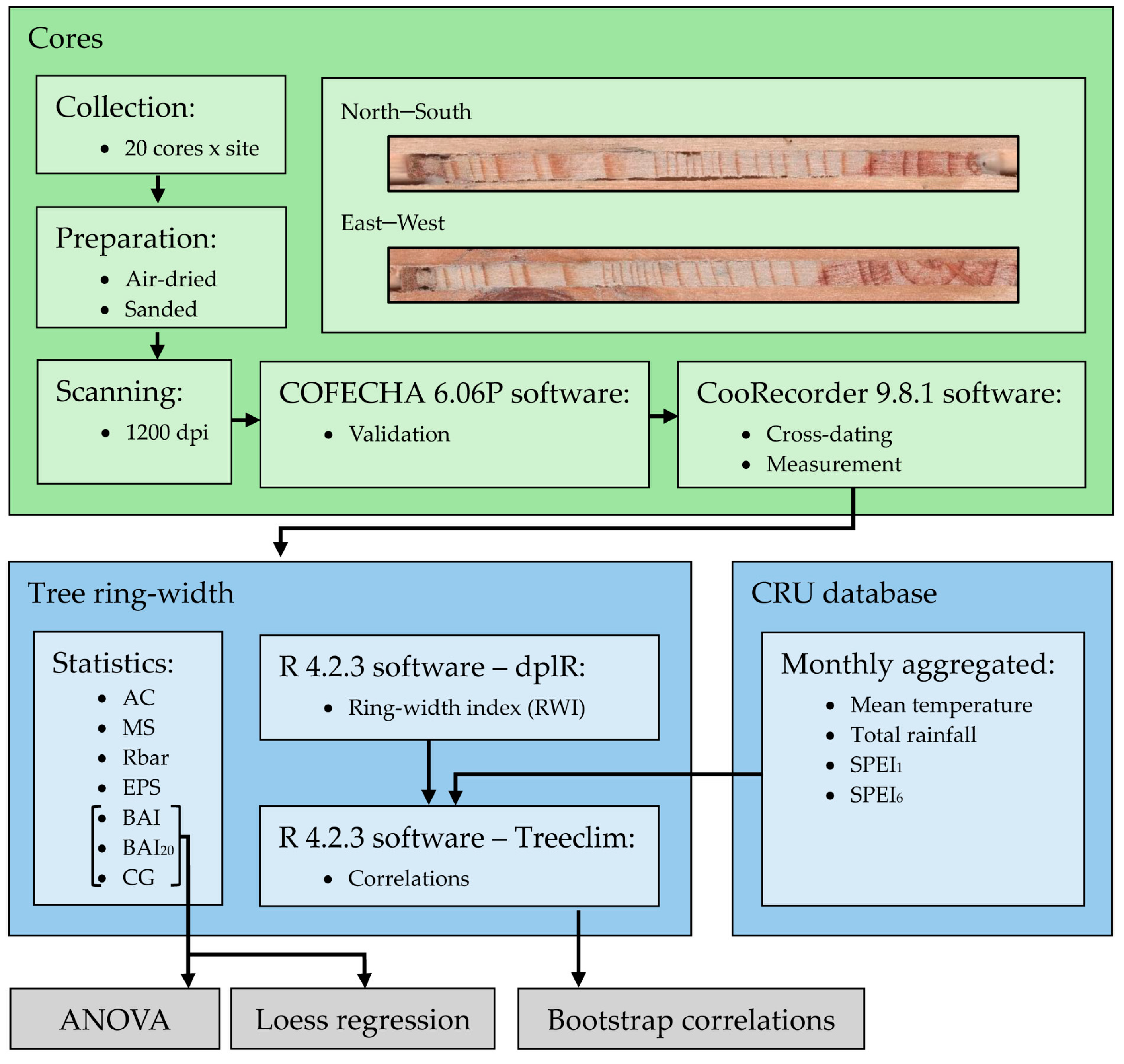
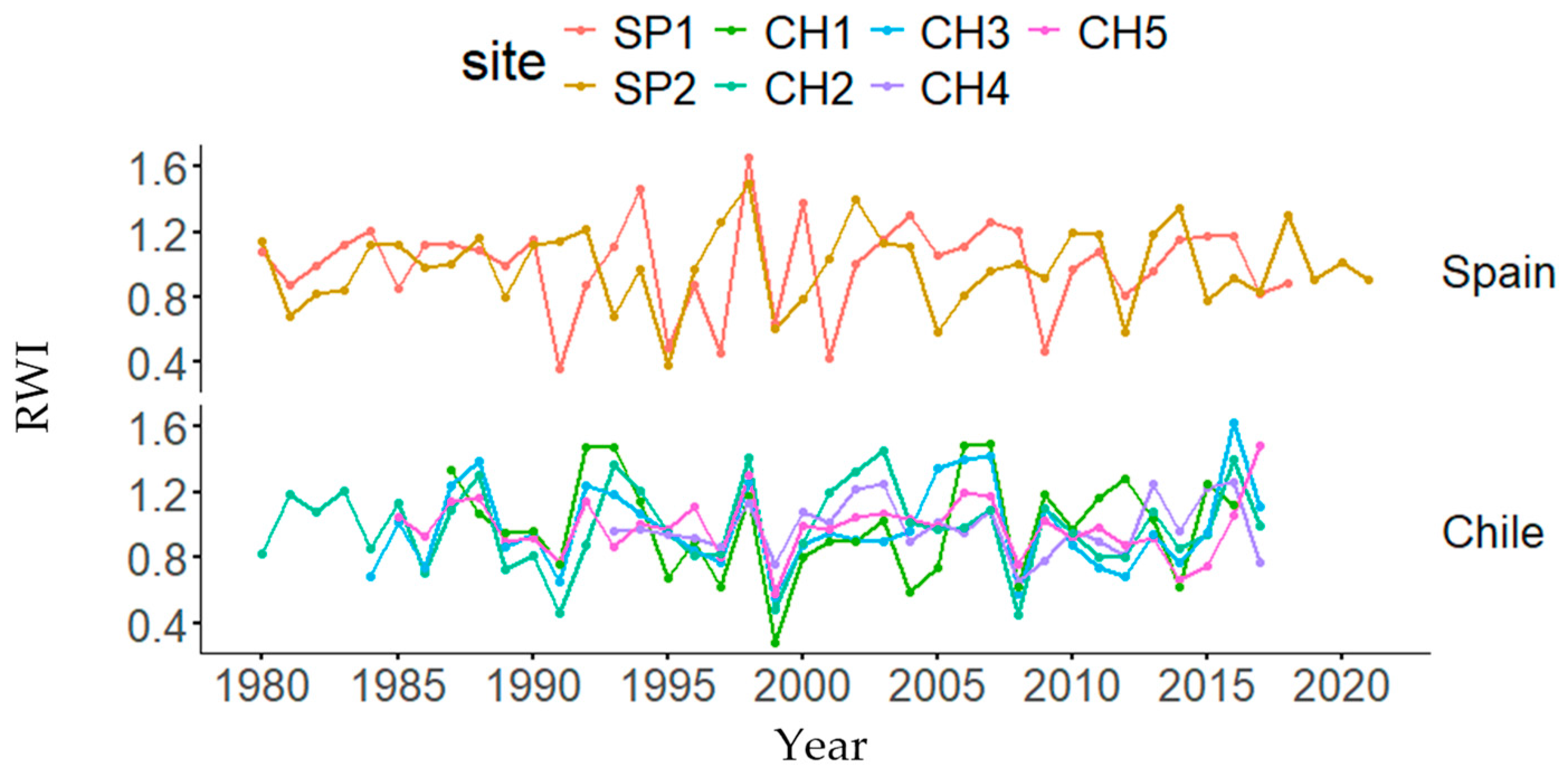
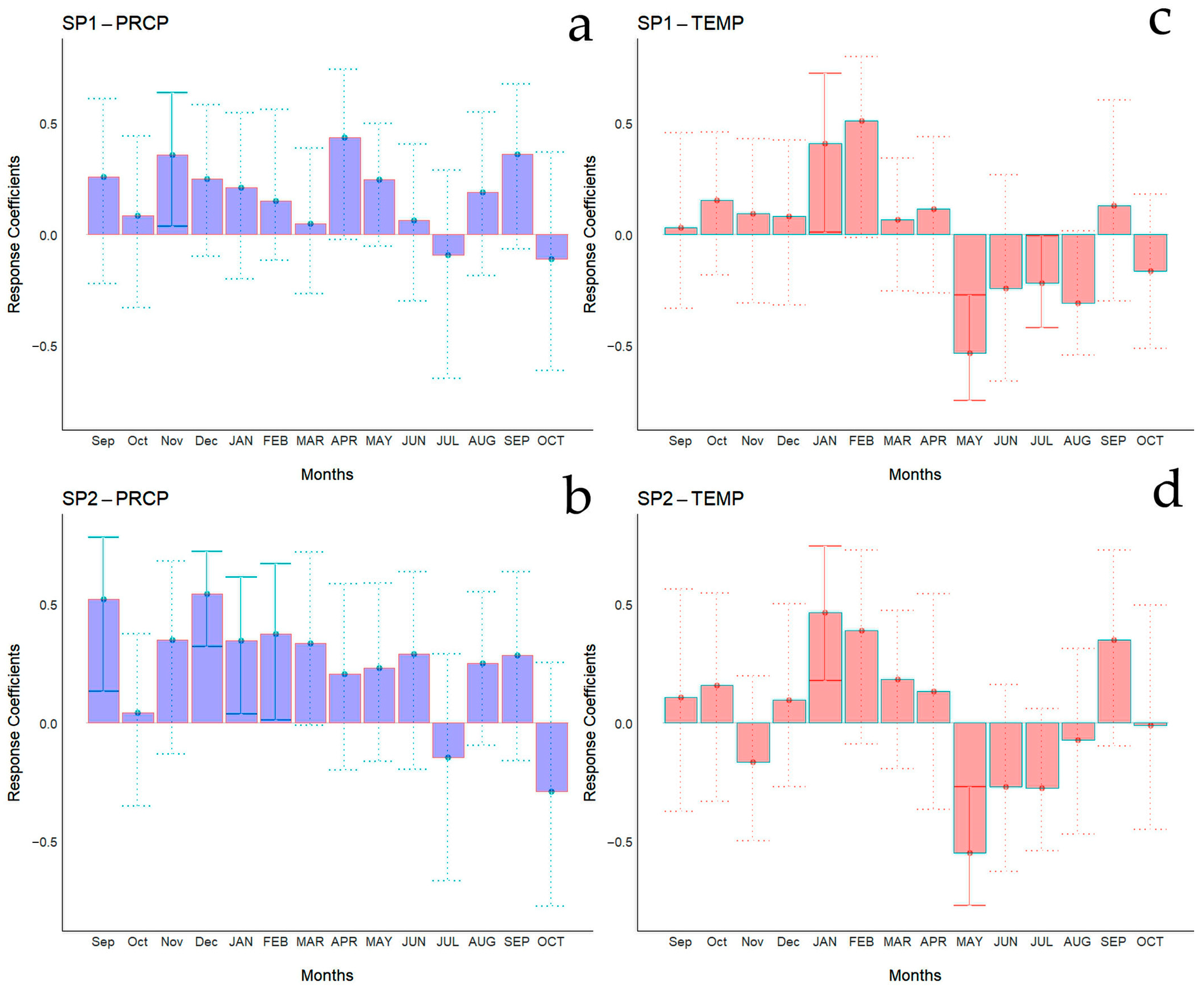
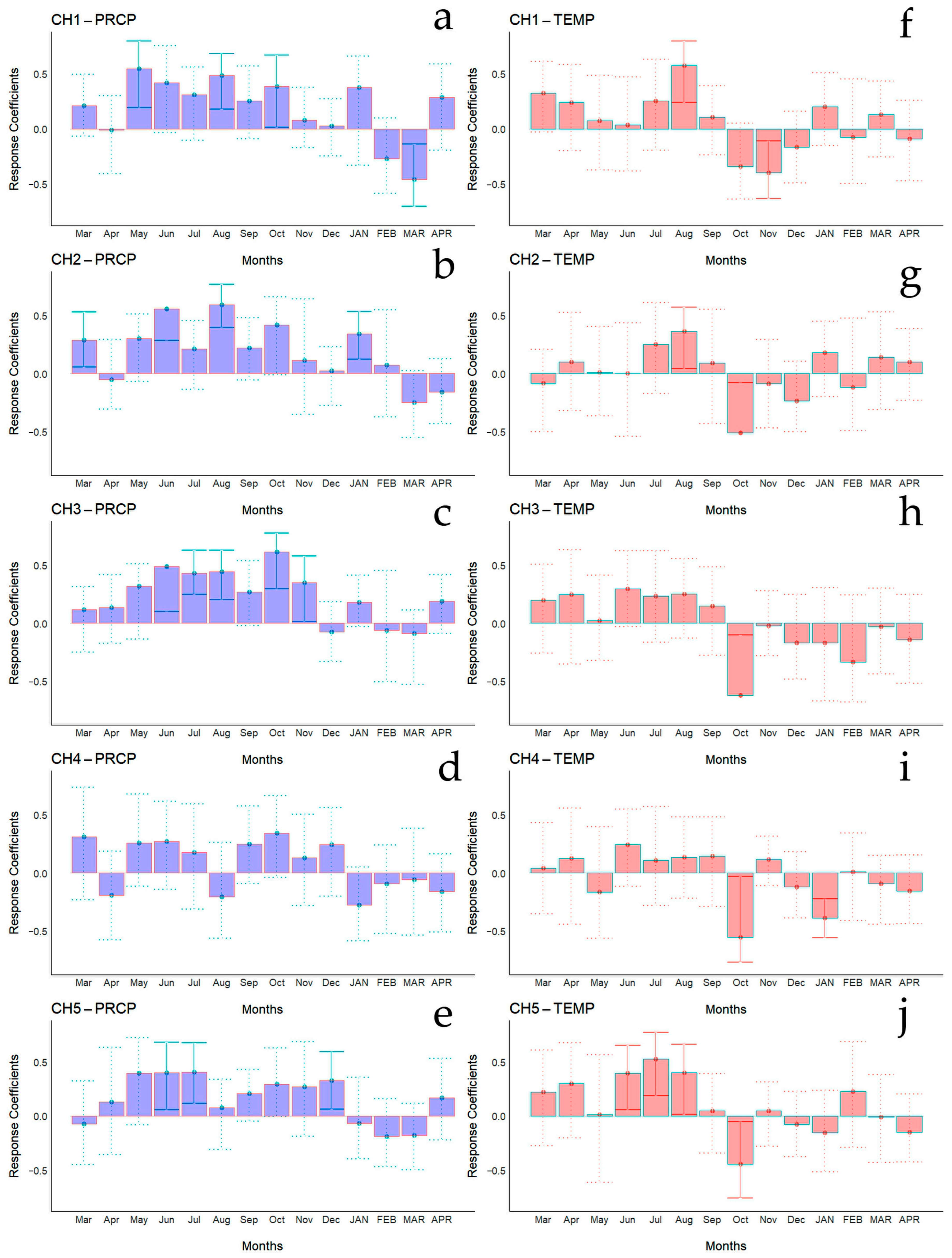
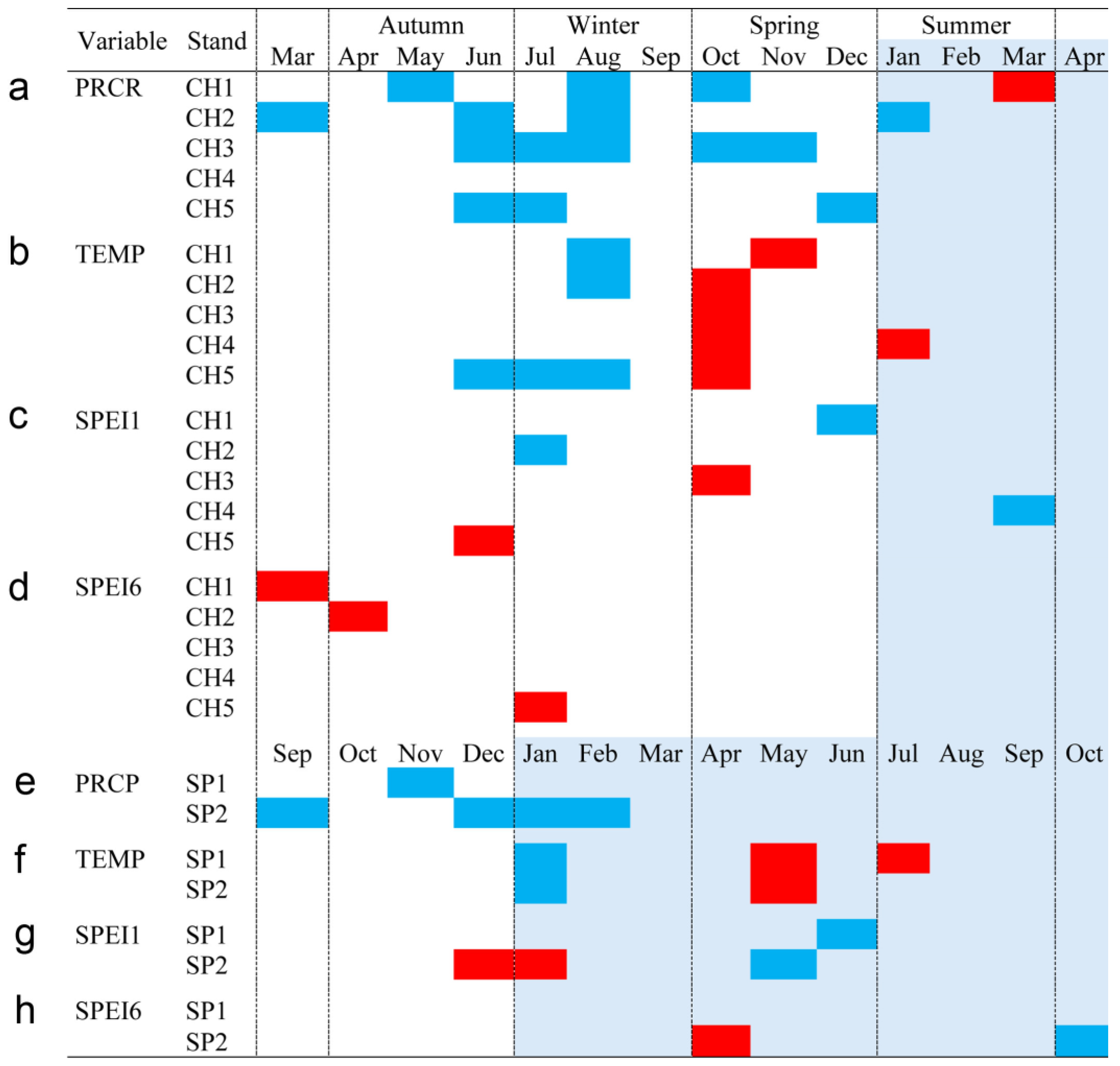
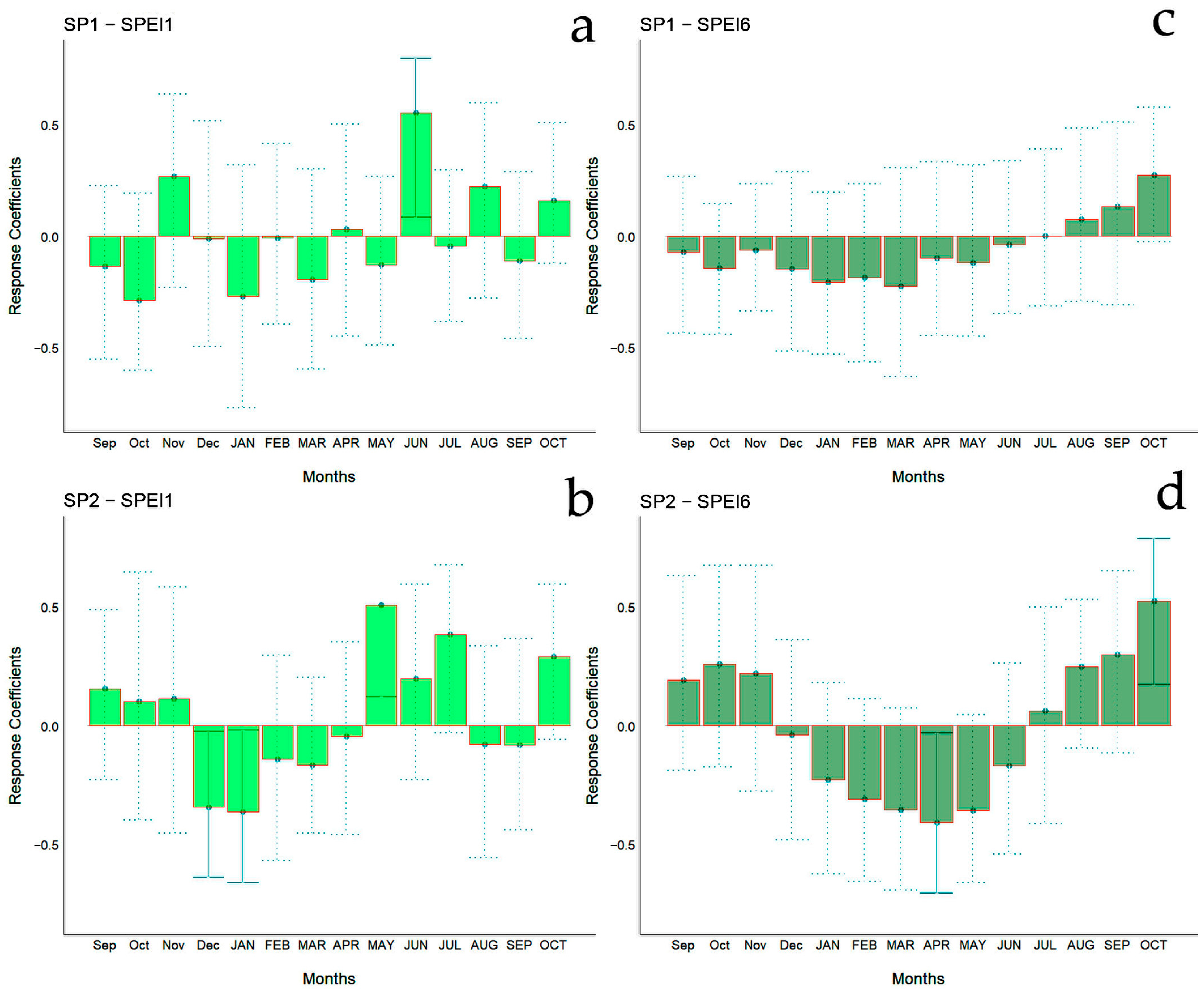
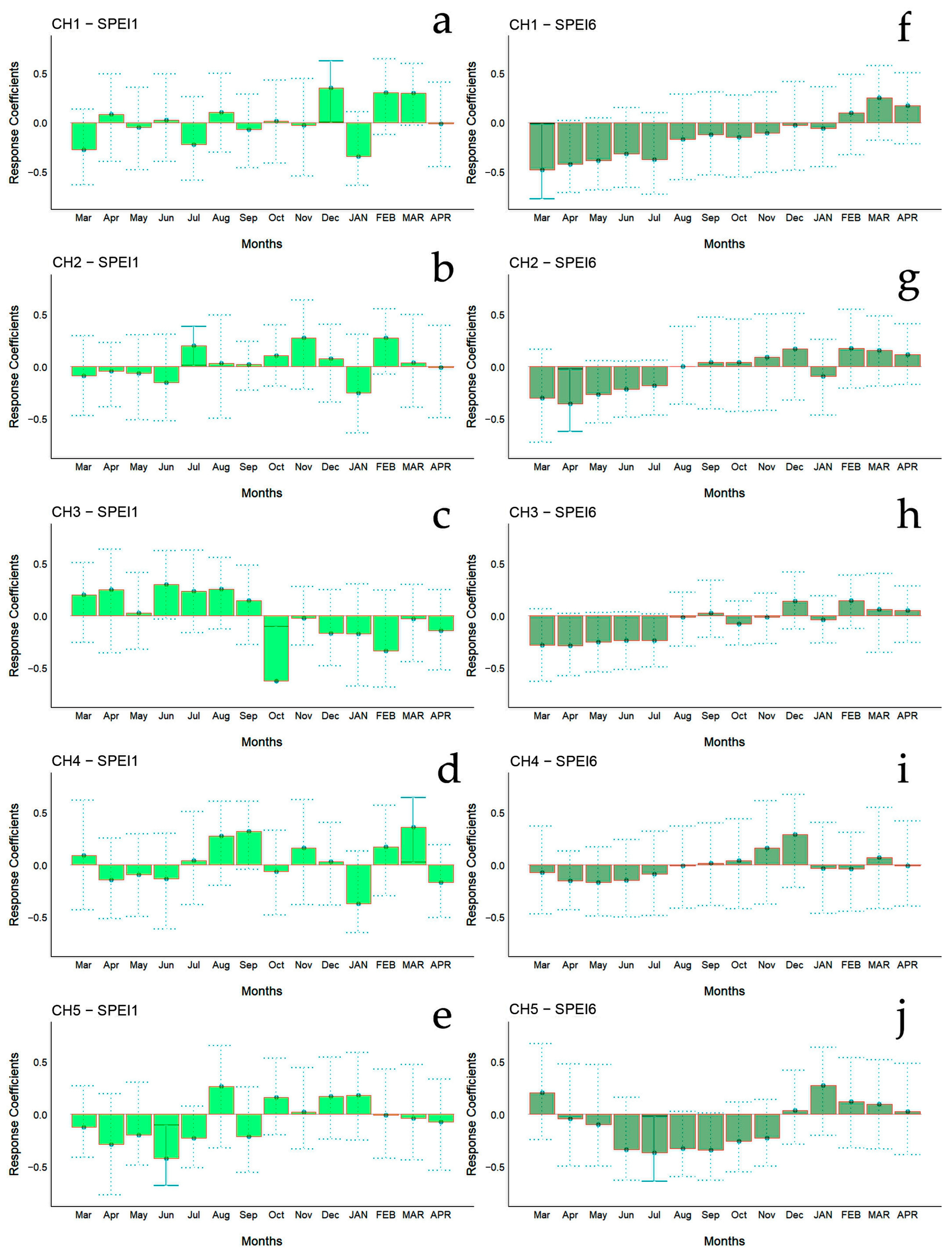
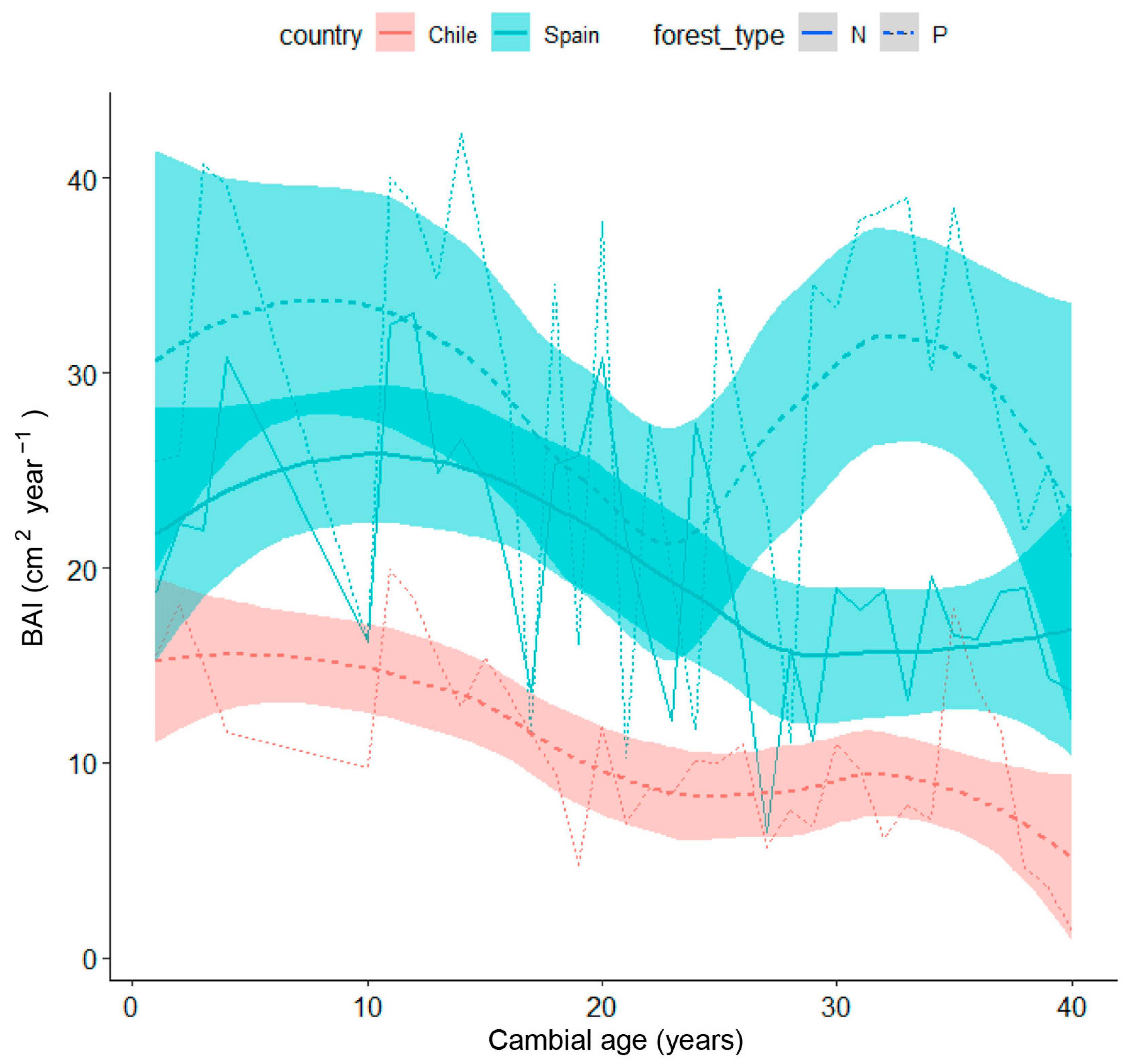
| Country | Site | Location | Forest | Soil and Climate | |||||||
|---|---|---|---|---|---|---|---|---|---|---|---|
| Latitude | Longitude | Density (Trees ha−1) | Timespan | Age at Sampling (Years) | Type | Textural Class | Annual Rainfall (mm) | Average Temp. (°C) | Description | ||
| Spain | Doñana | 37°2′ N | 6°35′ W | 180 | 1964–2017 | 54 | P | Sandy | 572 | 17.4 | Mediterranean oceanic |
| Sierra Morena | 37°59′ N | 4°48′ W | 250 | 1927–2021 | 95 | N | Sandy | 518 | 17.9 | Xeric Mediterranean | |
| Chile | Peñuelas | 33°11′ S | 71°29′ W | 833 | 1977–2017 | 40 | P | Loam | 384 | 13.6 | Warm-summer Mediterranean with winter rain and coastal influence |
| Cahuil | 34°30′ S | 72°00′ W | 400 | 1987–2016 | 33 | P | Loam | 497 | 14.1 | Warm-summer Mediterranean with winter rain and coastal influence | |
| Paredones | 34°42′ S | 71°53′ W | 625 | 1985–2017 | 35 | P | Sandy clayloam | 551 | 14.5 | Warm-summer Mediterranean with winter rain | |
| Manquimiliu | 36°19′ S | 72°31′ W | 625 | 1993–2017 | 24 | P | Loam | 816 | 13.2 | Warm-summer Mediterranean with winter rain | |
| Pastene | 38°12′ S | 72°60′ W | 625 | 1984–2017 | 33 | P | Loam | 1072 | 10.9 | Warm-summer Mediterranean with winter rain | |
| Country | Site (Code) | No. Trees (No. Cores) | BAI (cm2 y−1) † | BAI20 (cm2 y−1) † | CG (cm) † | AC | MS | Rbar | EPS |
|---|---|---|---|---|---|---|---|---|---|
| Spain | Doñana (SP1) | 16 (31) | 23.9 ± 0.02 | 31.9 ± 0.02 | 22.9 ± 1.66 | 0.40 | 0.45 | 0.63 | 0.87 |
| Sierra Morena (SP2) | 20 (39) | 13.6 ± 0.01 | 25.3 ± 0.01 | 20.8 ± 1.16 | 0.67 | 0.39 | 0.49 | 0.85 | |
| Chile | Peñuelas (CH1) | 20 (39) | 9.4 ± 0.01 | 9.9 ± 0.01 | 14.5 ± 0.91 | 0.81 | 0.42 | 0.56 | 0.86 |
| Cahuil (CH2) | 20 (39) | 10.9 ± 0.01 | 12.3 ± 0.01 | 12.5 ± 0.94 | 0.88 | 0.41 | 0.53 | 0.86 | |
| Paredones (CH3) | 20 (40) | 12.3 ± 0.01 | 14.4 ± 0.01 | 11.3 ± 0.93 | 0.71 | 0.39 | 0.48 | 0.85 | |
| Manquimiliu (CH4) | 18 (36) | 14.3 ± 0.01 | 16.9 ± 0.01 | 12.2 ± 1.22 | 0.69 | 0.35 | 0.71 | 0.89 | |
| Pastene (CH5) | 15 (30) | 12.5 ± 0.01 | 15.2 ± 0.02 | 14.2 ± 1.13 | 0.66 | 0.34 | 0.76 | 0.90 |
Disclaimer/Publisher’s Note: The statements, opinions and data contained in all publications are solely those of the individual author(s) and contributor(s) and not of MDPI and/or the editor(s). MDPI and/or the editor(s) disclaim responsibility for any injury to people or property resulting from any ideas, methods, instructions or products referred to in the content. |
© 2024 by the authors. Licensee MDPI, Basel, Switzerland. This article is an open access article distributed under the terms and conditions of the Creative Commons Attribution (CC BY) license (https://creativecommons.org/licenses/by/4.0/).
Share and Cite
Loewe-Muñoz, V.; Cachinero-Vivar, A.M.; Camarero, J.J.; Río, R.D.; Delard, C.; Navarro-Cerrillo, R.M. Dendrochronological Analysis of Pinus pinea in Central Chile and South Spain for Sustainable Forest Management. Biology 2024, 13, 628. https://doi.org/10.3390/biology13080628
Loewe-Muñoz V, Cachinero-Vivar AM, Camarero JJ, Río RD, Delard C, Navarro-Cerrillo RM. Dendrochronological Analysis of Pinus pinea in Central Chile and South Spain for Sustainable Forest Management. Biology. 2024; 13(8):628. https://doi.org/10.3390/biology13080628
Chicago/Turabian StyleLoewe-Muñoz, Verónica, Antonio M. Cachinero-Vivar, Jesús Julio Camarero, Rodrigo Del Río, Claudia Delard, and Rafael M. Navarro-Cerrillo. 2024. "Dendrochronological Analysis of Pinus pinea in Central Chile and South Spain for Sustainable Forest Management" Biology 13, no. 8: 628. https://doi.org/10.3390/biology13080628
APA StyleLoewe-Muñoz, V., Cachinero-Vivar, A. M., Camarero, J. J., Río, R. D., Delard, C., & Navarro-Cerrillo, R. M. (2024). Dendrochronological Analysis of Pinus pinea in Central Chile and South Spain for Sustainable Forest Management. Biology, 13(8), 628. https://doi.org/10.3390/biology13080628









